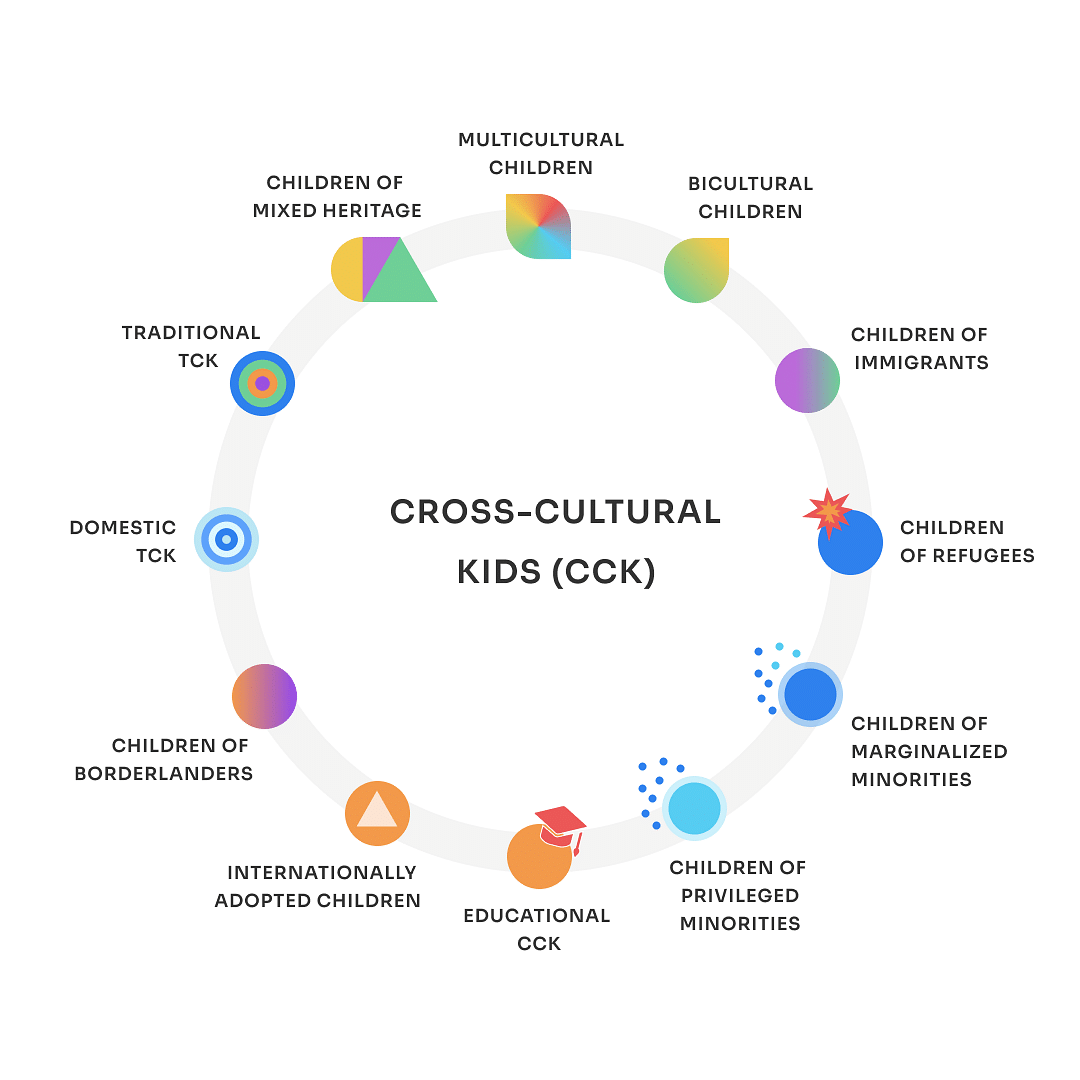This is Part II of our Cultural Mosaics series where I will be outlining four Cross-Cultural Kid (CCK) categories by using the pictograms developed during the Cultural Mosaics collaboration. The Cross-Cultural Kids model was develop by researcher Ruth van Reken.
Cultural Mosaics is a collaboration between Wiebke Homborg, from Chameleon Coaching, and myself, Beatriz Nour from the inbetweenish, where we carefully break down each of the 12 Cross-Cultural Kid categories one by one, simplifying them into basic shapes.
In this article, we will start off by looking at Children of Refugees and Children of Immigrants, two categories that are wrongfully used interchangeably. Next, we will look at minority categories of which there are two: Children of Privileged Minority Groups and Children of Marginalized Minority Groups.

Refugees and Immigrants are not Synonymous
Before we dive into children of refugees and children of immigrants, it’s worth understanding the differences between these terms: refugees, immigrants, and migrants, because that is where the confusion begins. In mainstream media, and often for political purposes, these terms can intentionally be confused for one another, however, they are not the same.
The main difference between these three situations comes down to choice. According to the UNHCR, Refugees flee their home countries for fear of “direct threat of persecution or death” and they cannot safely return to their home countries. Immigrants, on the other hand, make a conscious decision to leave their home country to move to a foreign country with the intention of settling there long term as a permanent residents and eventually seeking citizenship. Lastly, migrants are typically people who choose to move from place to place for economic reasons and better opportunities such as seasonal work.
Now, you may be wondering, where do children come in? So let’s break down the individual experiences.

Children of refugees refers to individuals who are born to parents who have sought refuge in another country due to persecution, violence, conflict, or other forms of adversity in their home country.
Experience: Children from refugee backgrounds often develop resilience, empathy, and a keen cultural awareness through their experiences. However, many have also endured trauma in their home countries, during their journeys, seeking asylum, or upon arrival in their host country. They may grapple with language barriers, acculturation stress, discrimination, and integration hurdles, all of which significantly impact their mental health and academic performance.
Unfortunately, schools and communities, though well-intentioned, often lack the necessary resources to adequately support refugee children. There's a pressing need for cultural awareness programs, trauma-informed counseling, language assistance, and mentorship initiatives to foster a sense of belonging, integration, and language skill development.
In the past decade, the global number of refugees has more than doubled, and nearly half of them are children. These children and their families need global solidarity and support to ensure they have access to essential services like education, healthcare, social protection, and enabling them to rebuild their lives with dignity and hope.
Reflect on: How can we ensure that children of refugees feel safe and welcome in our community or school?
Dive deeper into the refugee experience with inbetweenish episodes:
🌳 "notions of home" with Baharak — a former child refugee, as we explore the concept of home, her journey, and where she finds her roots
🕊️ “bonus: let’s talk about refugees” featuring Baharak — where we outline the refugee experience and address common misconceptions

Children of Immigrants are children whose parents have made a permanent move to a new country, for various reasons, and eventually seek citizenship status.These children grow up with a dual cultural identity, influenced by the culture of their parents' home country and the culture of the country they are raised in.
Experience: There are a number of factors that may greatly shape the experience of immigrating to a new country, such as: reason for immigration, language proficiency, network in host country, financial situation, job opportunities available to immigrants, etc. These factors also shape the experiences of children of immigrants (who may have one immigrant or two immigrant parents).
Children of immigrants often benefit from being bilingual or multilingual, bringing diverse perspectives with cross-cultural competence, and enriching the cultural landscape of their countries. They're resilient, adaptable, and adept at navigating change. While they maintain connections with their parents' home country(ies) through vacations and family networks, they may also grapple with identity confusion and the challenge of balancing multiple cultural identities and expectations.
Often times, their ethnic or cultural background may subject them to biases or discrimination, which can impact their self-esteem and social integration. Some children may assume disproportionate roles as translators or family organizers, and they often feel pressure to excel academically and professionally to honor their parents' sacrifices.
Reflect on: What preconceptions might you have about immigrants in your country?
Dive deeper into the immigrant experience with inbetweenish episodes:
🎹 it is not with bones and skin, it’s all with feeling — with Axel [Part I]
🎹 a man is synonymous with describing a soldier — with Axel [Part II]
Not all Minority Groups are Created Equally
Now, let's explore children of minorities, both marginalized and privileged. When discussing minorities within the context of Cross-Cultural Kids, we refer to the minority experience within your home country. This excludes the experience of immigrating to another country and subsequently becoming a minority group within the new host country.

Children of Marginalized Minorities refer to children of people who experience systemic, social, economic, or political disadvantages and are often excluded or disadvantaged by mainstream society. They face discrimination, oppression, and limited access to resouces and opportunities.
Experience: The upbringing of children from marginalized minority backgrounds varies depending on their minority status relative to the majority. In some cases, they may not recognize their minority identity, particularly when raised in insular subcultures with minimal interaction with the majority.
These children often grapple with dual challenges: systemic discrimination and marginalization. "Us vs. them" sentiments within families and societies can deepen divides between minority and majority groups, leading to disparities in education, employment, and housing. This division may even affect interfaith, intercultural, or interracial relationships.
Unfortunately, marginalized groups face heightened risks of abuse, violence, exploitation, and human rights violations. These experiences profoundly impact their identity, potentially causing self-esteem issues, internalized racism, and mental health issues. However, children of minority groups also bring richness and diversity to their communities. They often master the art of code-switching, seamlessly moving between languages, contexts, and cultures. They are, in essence, cultural chameleons.
Reflect on: What beliefs do you have about minority groups in your country? Who or what has instilled these beliefs in you?

Children of Privileged Minorities refers to children of people who, despite being considered minorities in terms of numerical representation, possess social, economic, or political advantages in society. These advantages are typically derived from factors such as wealth, education, social status, or historical and systemic advantages. Examples of historically privileged minorities: Brahmins in India, White South Africans.
Experience: Growing up as a child of a privileged minority can be tricky to manoeuvre, especially as many people don’t realize that they are, in fact, privileged until they leave their bubble. They may sometimes be culturally influenced by the majority, but that is not always the case. It’s important to remember that privilege is a nuanced topic depending on various factors such as the nature of the privilege, the child's upbringing, and their exposure to diversity. While you may be privileged in certain areas, you may also be disadvantaged in others aspects of your identity.
Children of privileged minorities often have better access to quality education, healthcare, and extracurricular activities, contributing to their overall development and success. This access can boost their confidence and self-esteem. Exposure to influential community members can provide valuable networking opportunities, which may prove beneficial later in life. Moreover, they may develop a strong sense of cultural identity and pride, benefiting from access to cultural preservation efforts and resources.
However, growing up in a privileged minority group can have drawbacks. Limited exposure to the challenges faced by less privileged groups may lead to a lack of awareness and empathy for social inequalities. Some may develop entitlement, expecting special treatment without appreciating others' efforts. In addition, academic or professional success to maintain group status can cause stress. Lastly, some privileged children may grapple with feelings of guilt or obligation regarding their advantages or the expectation to "give back" to less privileged communities, which can be emotionally challenging.
Reflect on: Are a member of a privileged minority group, and if so, how has this shaped you? How can you use your privilege to make a difference?
It's Important to Remember
Understanding the diverse experiences of Cross-Cultural Kids (CCKs) is crucial. These experiences involve exchanges across cultures, influenced by factors like power dynamics, privileges, disadvantages, and freedom of movement. CCKs often fit into multiple categories simultaneously. For instance, a child who was once a refugee may later become a child of immigrants upon settling in a new country and seeking citizenship. Alternatively, children of marginalized minority groups may immigrate to escape discrimination or become refugees due to persecution.
Overlap is common among CCK experiences, highlighting the complexity of their backgrounds. It's essential to recognize these nuances to grasp the implications of each CCK experience. Lastly, it’s important to remember that these are generalized experiences. At the end of the day, each child is unique due to individual variables that the CCK model does not account for such as family name and status, financial situation of the families they belong to, and involvement of parents and extended families in their upbringing.
Cultural Mosaics Articles: Each Category Explained
Cultural Mosaics Part I — Understanding Cross-Cultural Kids and how they differ from Third Culture Kids
Cultural Mosaics Part II — Children of Refugees, Children of Immigrants, Children of Marginalized Minorities, + Children of Privileged Minorities
Cultural Mosaics Part III — Third Culture Kids, Domestic Third Culture Kids, Educational Cross-Cultural Kids, + Children of Borderlanders
Cultural Mosaics Part IV — Bicultural Children, Multicultural Children, Children of Mixed Heritage, + Internationally Adopted Children
For more information on navigating cross-cultural experiences, listen to: 💭 reflections on: what happens when you belong to different cultures where I highlight the internal and external battles you face when you juggle multiple belongings.
